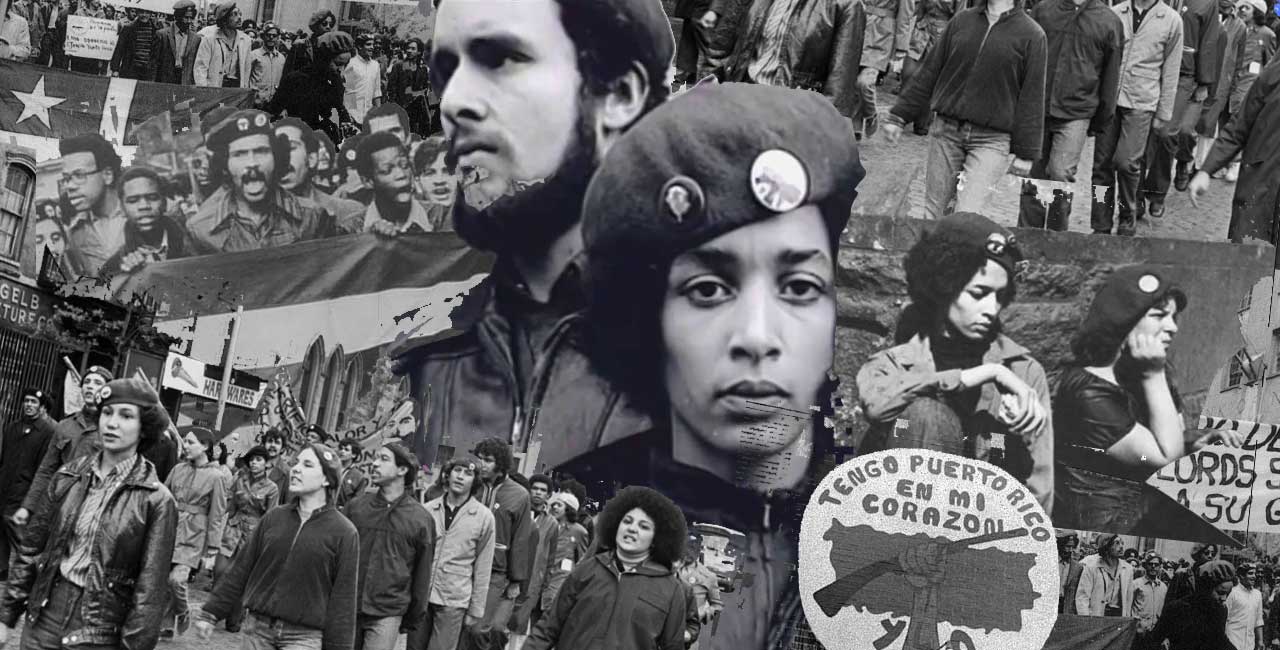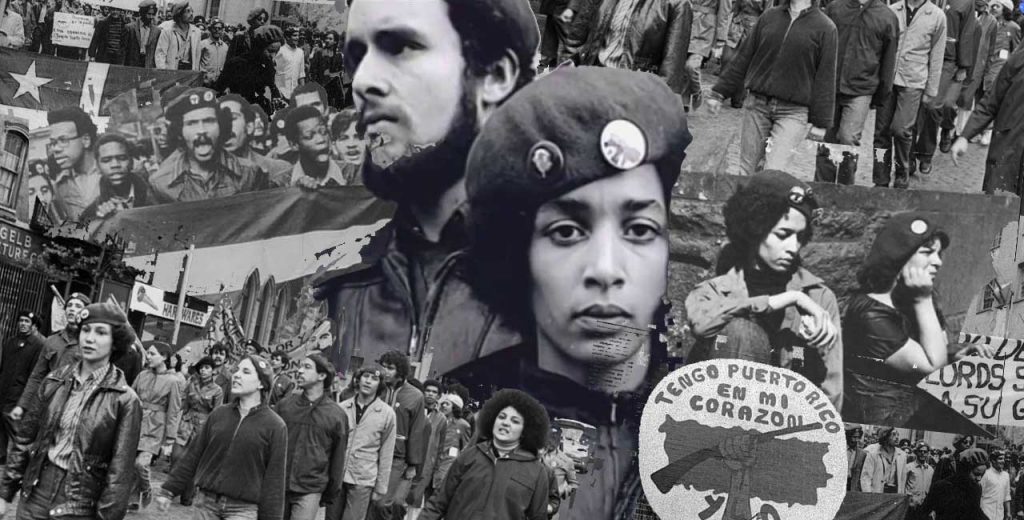Inspired by the Black Panthers, the Young Lords was a Chicago street gang-turned-national political and social action organization fighting for the liberation, self-determination and justice of Puerto Ricans, Latinxs and Third World people in the late 1960s to the mid-1970s. The members were largely the children of Puerto Rican migrants, a growing population in barrios across the Northeast who journeyed to the United States mainland in search of economic and housing opportunities. Instead of possibility, they saw poverty, discrimination, and exploitation.
Deeply concerned with issues impacting low-income communities of color, the Young Lords held a socialist, community-driven vision for society. While the party’s widely remembered for its “serve the people” programs throughout the streets of New York City, its activism started with a battle against gentrification in the Lincoln Park neighborhood of Chicago and ended with pro-independence efforts on the island. Here, more on the under-told story of one of the most pivotal and impactful Latinx activist groups in the U.S.
1
From the Young Lords Organization to the Young Lords Party
Emerging as a Chicago street gang, the Young Lords politicized when founder José “Cha Cha” Jiménez was released from prison, where a Black Muslim librarian sparked his interest in social justice by teaching him about Black revolutionaries in 1968. He spread his newfound knowledge with his fellow members, also informing them about housing issues in their neighborhood, and the group soon refocused its fight against racist local government. The group, called the Young Lords Organization, grew, even catching the attention of activist-minded Puerto Rican students in New York, who traveled to Chicago, met with Jiménez and together established a chapter in their city in 1969. In New York, which had the largest Puerto Rican population in the country at the time, membership skyrocketed, and after several efforts that helped gain them the respect of their community, they became a political force. In the early 1970s, they disconnected from the Chicago branch, who were also experiencing some changes, and established themselves as the Young Lords Party.
2
A Multiracial and Multicultural Organization
While predominantly Puerto Rican, the Young Lords membership included several non-Boricua Latinxs, particularly Dominicans, Cubans, Panamanians, and Mexicans, as well as African-Americans. In fact, one of the first female members of the group was Sonia Ivany, a young Cuban mother and university student, who volunteered for the New York chapter’s early “garbage offensive,” which included several street-cleanings, while the party’s first female in a leadership position was African-American Denise Oliver-Velez, who held the title of minister of finance.
3
The Young Lords Party Was a Multi-Issue, Intersectional Organization
The 1960s was a time of social revolution, and many members of the Young Lords arrived after or while organizing for other social justice movements, from students, labor organizers, anti-war activists and Vietnam War veterans to Black Panthers and similar Black liberation leaders, pro-independence Puerto Ricans, women’s rights activists and gay rights leaders to everyday mothers, gang members and individuals recovering from addiction. As such a diverse collective, it was pivotal for the group to explicitly take a stance on these social matters, which it did through its 13-Point Program and Platform. Through this, the Young Lords separated themselves from previous nationalist groups, which often espoused sexist and homophobic practices, by becoming one of the first to oppose machismo, racism, capitalism and violence and support education, socialism, community control and liberation for all.
And members walked the talk. In 1970, chairman Felipe Luciano was demoted after breaking a few of the organization’s rules of discipline, one of them being “male chauvinism,” while the Young Lords Party, largely pushed by its women’s caucus, went on to fight for women’s rights issues like calling for the end of the forced sterilization of Puerto Rican women, demanding safe and legal abortion and contraception, providing free childcare, questioning gender norms and condemning gender-based violence. This also allowed the group to challenge ideas of gender and sexual identities, opening the door for LGBTQ members. While not an official member of the Young Lords, one of the more popular queer individuals to participate with the party was Sylvia Rivera. The Puerto Rican-Venezuelan trans activist worked and marched with the group, once even saying, “Anytime they needed help, I was always there for the Young Lords. It was just the respect they gave us as human beings. They gave us a lot of respect.”
4
Practical Activism and Institutional Change
The self-described “revolutionary nationalists” worked to solve community issues through a combination of practical, hands-on solutions and larger actions that demanded government attention and led to institutional change. After polling New York residents on their most pressing concerns, the Young Lords established “serve the people” programs, which offered an immediate response to the needs of community members: street clean-ups, breakfast for students, clothing donations, walking children to and from school, health testing and political education – all at no cost to the people.
But the group also created change in New York health care, criminal justice and sanitation. In the late 1960s, sanitation service in East Harlem was all but absent. After taking matters into its own hands with street cleanings, the Young Lords noticed that the bags of trash it had collected were still not being picked up. To seize the city’s attention, members lit the garbage ablaze, bringing firefighters, law enforcement and press to the area and improving garbage service. In 1970, the Young Lords took on health care, hijacking a mobile chest X-ray unit that didn’t service high-risk neighborhoods and operating the vehicle 12 hours a day, seven days a week on their blocks. The same year, it held the “Lincoln Offensive,” when group members took over the South Bronx’s run-down Lincoln Hospital, which had high levels of lead content in the walls, for nearly 12 hours, demanding infrastructural upkeep as well as door-to-door preventative health services, drug addiction care, maternal and child care services, and senior citizen care. Its action helped lead to the construction of a new Lincoln Hospital.
5
Continuing Activism
The Young Lords, which grew outside of Chicago and New York to form branches in Philadelphia, Connecticut, New Jersey, Boston, Milwaukee, Hayward, California, San Diego, Los Angeles, and Puerto Rico, declined in the mid-1970s, but many of its leaders and members continued the work through careers across various fields and disciplines, including print and broadcast journalism, book publishing, academia, law, politics, film and organizing. Its legacy has inspired and taught new generations of activists, from artists like Hurray for the Riff Raff to current Latinx organizations like Mijente, and its under-told story is gaining more attention thanks to works like Through The Eyes of Rebel Women, written by former Young Lord Iris Morales and the forthcoming When the World Was Their Stage by Dominican-American scholar and professor of Black and Latino studies at Baruch College Johanna Fernández.




